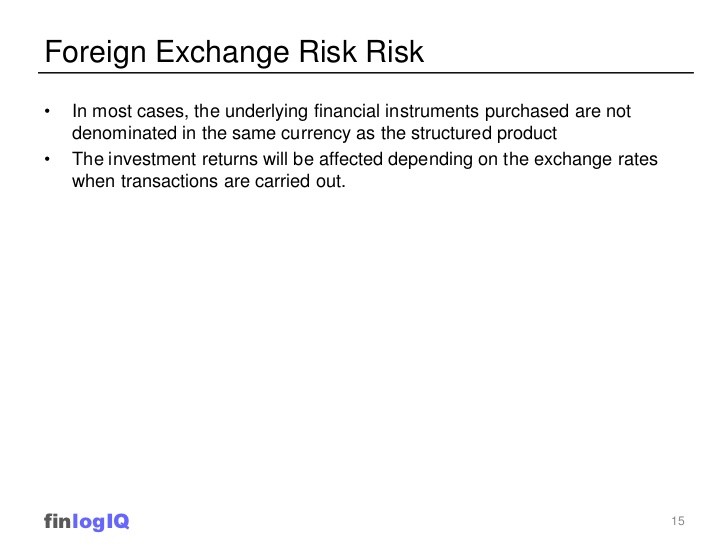How Exchange Risk Affects Foreign Bonds_1
Post on: 14 Май, 2015 No Comment

Investors often include foreign or international bonds in their portfolios for two primary reasons – to take advantage of higher interest rates or yields, and to diversify their holdings. However, the higher return expected from investing in foreign bonds is accompanied by increased risk arising from adverse currency fluctuations. Because of the relatively lower levels of absolute returns from bonds compared with equities, currency volatility can have a significant impact on bond returns. Investors should therefore be cognizant of exchange risk that comes with foreign bonds, and implement measures to mitigate currency risk .
Currency Risk and Foreign Bonds
Currency risk does not arise only from holding a foreign currency bond issued by an overseas entity. It exists any time an investor holds a bond that is denominated in a currency other than the investor’s domestic currency, regardless of whether the issuer is a local institution or a foreign entity.
Multinational companies and governments routinely issue bonds denominated in various currencies to benefit from lower borrowing costs, and also match their currency inflows and outflows. These bonds may be broadly classified as follows:
- Foreign bond: A bond issued by a foreign company or institution in a country other than its own, denominated in the currency of the country where the bond is issued. For example, a British company issuing a U.S. dollar currency bond in the U.S.
- Eurobond: A bond issued by a company outside its domestic market, denominated in a currency other than that of the country where the bond is issued. For example, a British company issuing a U.S. dollar currency bond in Japan. “Eurobond” does not refer to bonds issued only in Europe, but rather is a generic term that applies to any bond issued without a specific jurisdiction. Eurobonds are named after their currency of denomination. For example, Eurodollar bonds refer to USD-denominated Eurobonds, while Euroyen bonds refer to bonds denominated in Japanese yen.
- Foreign-pay bond: A bond issued by a local company in its local country that is denominated in a foreign currency. For example, a Canadian dollar-denominated bond issued by IBM in the United States would be a foreign-pay bond.
Currency risk arises from the currency of denomination of the bond and the location of the investor, rather than the domicile of the issuer. A U.S. investor who holds a yen-denominated bond issued by Toyota Motor is obviously exposed to currency risk. But what if the investor also holds a Canadian dollar-denominated bond issued by IBM in the U.S. Currency risk exists in this case as well, even though IBM is a domestic company. However, if a U.S. investor holds a Yankee bond or a Eurodollar bond issued by Toyota Motor, exchange risk does not exist despite the issuer being a foreign entity.
An Example

A slide in the currency in which your bond is denominated will lower total returns. Conversely, an appreciation in the currency will further boost returns from holding the bond — the icing on the cake, so to speak.
Consider a U.S. investor who purchased EUR 10,000 face value of a one-year bond, with a 3% annual coupon and trading at par. The euro was flying high at the time, with an exchange rate versus the U.S. dollar of 1.45, i.e. EUR 1 = USD 1.45. As a result, the investor paid $14,500 for the euro-denominated bond. Unfortunately, by the time the bond matured a year later, the euro had fallen to 1.25 against the U.S. dollar. The investor therefore received only $12,500 upon converting the maturity proceeds of the euro-denominated bond. In this case, the currency fluctuation resulted in a $2,000 forex loss.
The investor may have initially purchased the bond because it had a 3% yield. whereas comparable U.S. bonds of one-year maturity were only yielding 1%. The investor may also have assumed that the exchange rate would stay reasonably stable over the bond’s one-year holding period.
In this case, the positive yield differential of 2% offered by the euro bond did not justify the currency risk assumed by the U.S. investor. While the forex loss of $2,000 would be offset to a limited extent by the coupon payment of EUR 300 (assuming one interest payment made at maturity), the net loss from this investment still amounts to $1,625 (EUR 300 = USD 375). This equates to a loss of approximately 11.2% on the initial investment of $14,500.
Of course, the euro could as well have gone the other way. If it had appreciated to a level of 1.50 against the U.S. dollar, the gain arising from favorable forex fluctuation would have been $500. Including the coupon payment of EUR 300 or $450, total returns would have amounted to 6.55% on the initial $14,500 investment.
Hedging Currency Risk in Bond Holdings
Many international fund managers hedge currency risk rather than take the chance of returns being decimated by adverse currency fluctuations.
However, hedging itself carries a degree of risk since a cost is attached to it. As the cost of hedging currency risk is largely based on interest rate differentials. it can offset a substantial part of the higher interest rate offered by the foreign currency bond, thereby undermining the rationale for investing in such a bond in the first place. As well, depending on the method of hedging employed, the investor may be locked into a rate even if the foreign currency appreciates, thereby incurring an opportunity cost .
In a number of cases, however, hedging may be well worth it either to lock in currency gains or protect against a sliding currency. The most common methods employed to hedge currency risk are currency forwards and futures, or currency options. Each method of hedging has distinct advantages and disadvantages. Currency forwards can be tailored to a specific amount and maturity but lock in a fixed rate, while currency futures offer high leverage but are only available in fixed contract sizes and maturities. Currency options provide more flexibility than forwards and futures but can be quite expensive.
Foreign bonds may offer higher yields than domestic bonds and diversify the portfolio. However, these benefits should be weighed against the risk of loss from unfavorable forex moves, which can have a significant negative impact on total returns from foreign bonds.














